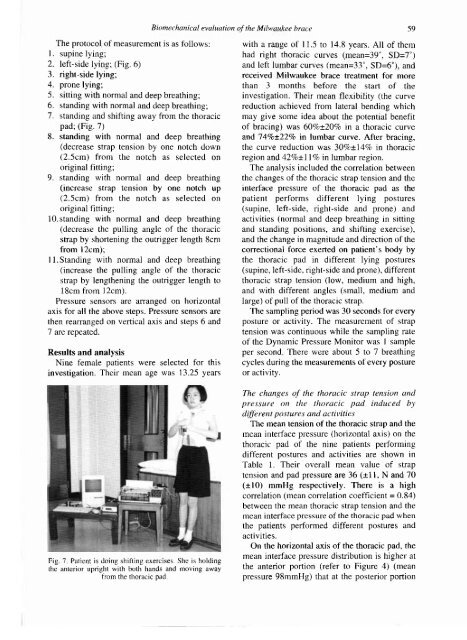Biomechanical evaluation of the Milwaukee brace
Biomechanical evaluation of the Milwaukee brace
Biomechanical evaluation of the Milwaukee brace
Create successful ePaper yourself
Turn your PDF publications into a flip-book with our unique Google optimized e-Paper software.
<strong>Biomechanical</strong> <strong>evaluation</strong> <strong>of</strong> <strong>the</strong> <strong>Milwaukee</strong> <strong>brace</strong> 59<br />
The protocol <strong>of</strong> measurement is as follows:<br />
1. supine lying;<br />
2. left-side lying; (Fig. 6)<br />
3. right-side lying;<br />
4. prone lying;<br />
5. sitting with normal and deep breathing;<br />
6. standing with normal and deep breathing;<br />
7. standing and shifting away from <strong>the</strong> thoracic<br />
pad; (Fig. 7)<br />
8. standing with normal and deep breathing<br />
(decrease strap tension by one notch down<br />
(2.5cm) from <strong>the</strong> notch as selected on<br />
original fitting;<br />
9. standing with normal and deep breathing<br />
(increase strap tension by one notch up<br />
(2.5cm) from <strong>the</strong> notch as selected on<br />
original fitting;<br />
10. standing with normal and deep breathing<br />
(decrease <strong>the</strong> pulling angle <strong>of</strong> <strong>the</strong> thoracic<br />
strap by shortening <strong>the</strong> outrigger length 8cm<br />
from 12cm);<br />
11. Standing with normal and deep breathing<br />
(increase <strong>the</strong> pulling angle <strong>of</strong> <strong>the</strong> thoracic<br />
strap by leng<strong>the</strong>ning <strong>the</strong> outrigger length to<br />
18cm from 12cm).<br />
Pressure sensors are arranged on horizontal<br />
axis for all <strong>the</strong> above steps. Pressure sensors are<br />
<strong>the</strong>n rearranged on vertical axis and steps 6 and<br />
7 are repeated.<br />
Results and analysis<br />
Nine female patients were selected for this<br />
investigation. Their mean age was 13.25 years<br />
with a range <strong>of</strong> 11.5 to 14.8 years. All <strong>of</strong> <strong>the</strong>m<br />
had right thoracic curves (mean=39°, SD=7°)<br />
and left lumbar curves (mean=33°, SD=6°), and<br />
received <strong>Milwaukee</strong> <strong>brace</strong> treatment for more<br />
than 3 months before <strong>the</strong> start <strong>of</strong> <strong>the</strong><br />
investigation. Their mean flexibility (<strong>the</strong> curve<br />
reduction achieved from lateral bending which<br />
may give some idea about <strong>the</strong> potential benefit<br />
<strong>of</strong> bracing) was 60%±20% in a thoracic curve<br />
and 74%±22% in lumbar curve. After bracing,<br />
<strong>the</strong> curve reduction was 30%±14% in thoracic<br />
region and 42%±11% in lumbar region.<br />
The analysis included <strong>the</strong> correlation between<br />
<strong>the</strong> changes <strong>of</strong> <strong>the</strong> thoracic strap tension and <strong>the</strong><br />
interface pressure <strong>of</strong> <strong>the</strong> thoracic pad as <strong>the</strong><br />
patient performs different lying postures<br />
(supine, left-side, right-side and prone) and<br />
activities (normal and deep breathing in sitting<br />
and standing positions, and shifting exercise),<br />
and <strong>the</strong> change in magnitude and direction <strong>of</strong> <strong>the</strong><br />
correctional force exerted on patient's body by<br />
<strong>the</strong> thoracic pad in different lying postures<br />
(supine, left-side, right-side and prone), different<br />
thoracic strap tension (low, medium and high,<br />
and with different angles (small, medium and<br />
large) <strong>of</strong> pull <strong>of</strong> <strong>the</strong> thoracic strap.<br />
The sampling period was 30 seconds for every<br />
posture or activity. The measurement <strong>of</strong> strap<br />
tension was continuous while <strong>the</strong> sampling rate<br />
<strong>of</strong> <strong>the</strong> Dynamic Pressure Monitor was 1 sample<br />
per second. There were about 5 to 7 breathing<br />
cycles during <strong>the</strong> measurements <strong>of</strong> every posture<br />
or activity.<br />
Fig 7. Patient is doing shifting exercises. She is holding<br />
<strong>the</strong> anterior upright with both hands and moving away<br />
from <strong>the</strong> thoracic pad.<br />
The changes <strong>of</strong> <strong>the</strong> thoracic strap tension and<br />
pressure on <strong>the</strong> thoracic pad induced by<br />
different postures and activities<br />
The mean tension <strong>of</strong> <strong>the</strong> thoracic strap and <strong>the</strong><br />
mean interface pressure (horizontal axis) on <strong>the</strong><br />
thoracic pad <strong>of</strong> <strong>the</strong> nine patients performing<br />
different postures and activities are shown in<br />
Table 1. Their overall mean value <strong>of</strong> strap<br />
tension and pad pressure are 36 (±11, N and 70<br />
(±10) mmHg respectively. There is a high<br />
correlation (mean correlation coefficient = 0.84)<br />
between <strong>the</strong> mean thoracic strap tension and <strong>the</strong><br />
mean interface pressure <strong>of</strong> <strong>the</strong> thoracic pad when<br />
<strong>the</strong> patients performed different postures and<br />
activities.<br />
On <strong>the</strong> horizontal axis <strong>of</strong> <strong>the</strong> thoracic pad, <strong>the</strong><br />
mean interface pressure distribution is higher at<br />
<strong>the</strong> anterior portion (refer to Figure 4) (mean<br />
pressure 98mmHg) that at <strong>the</strong> posterior portion
















